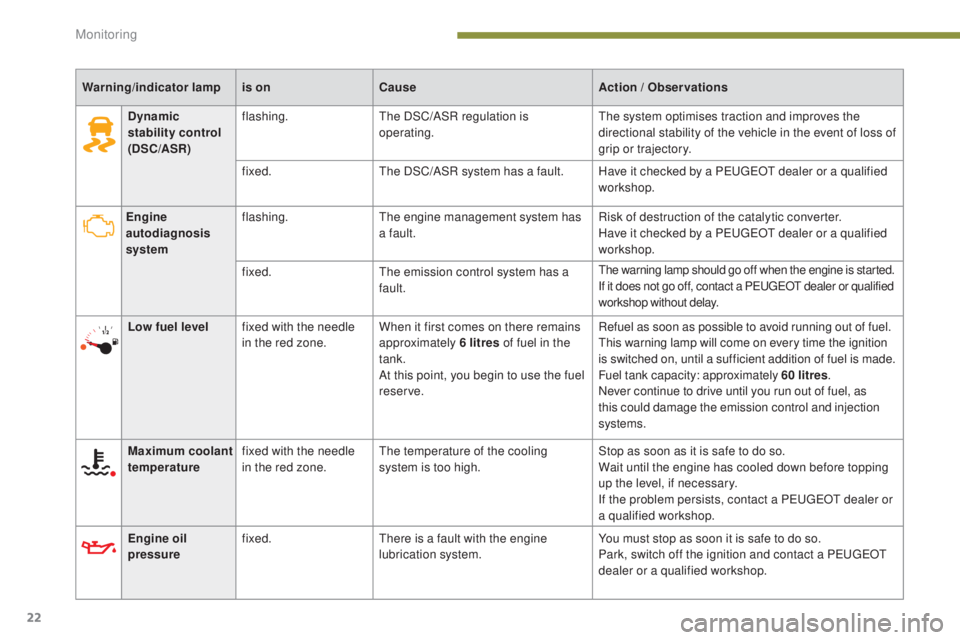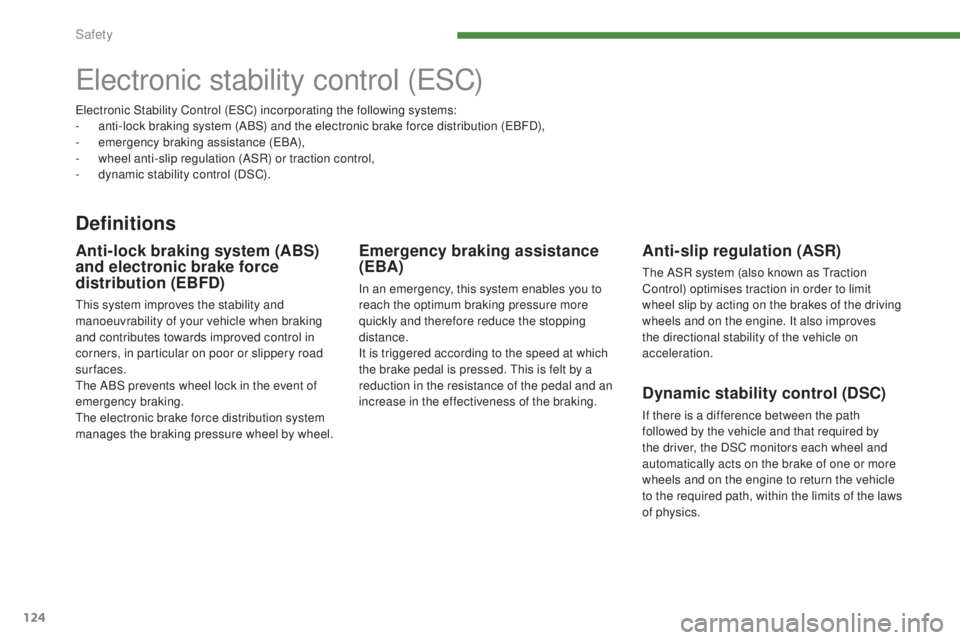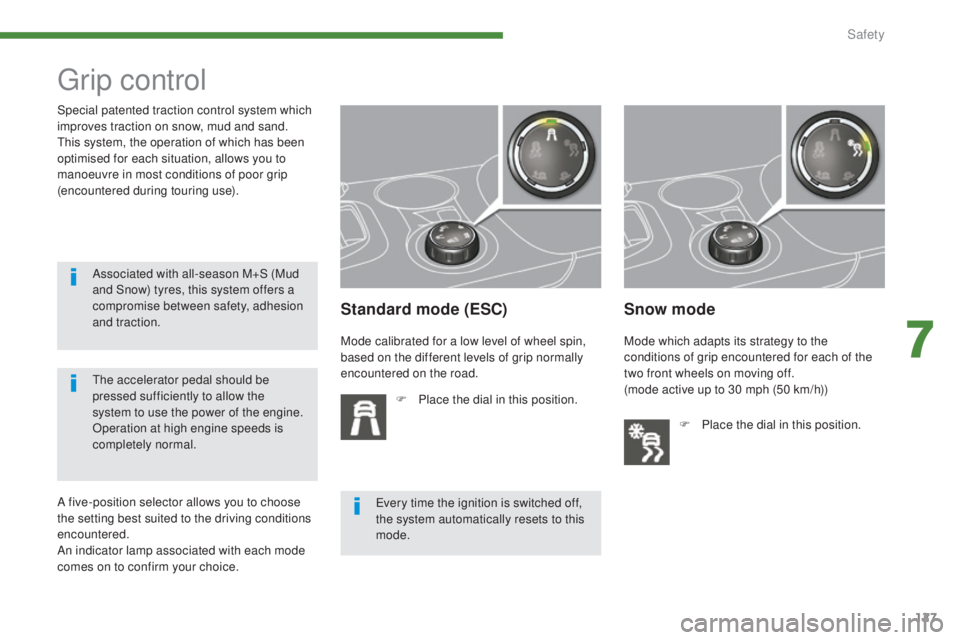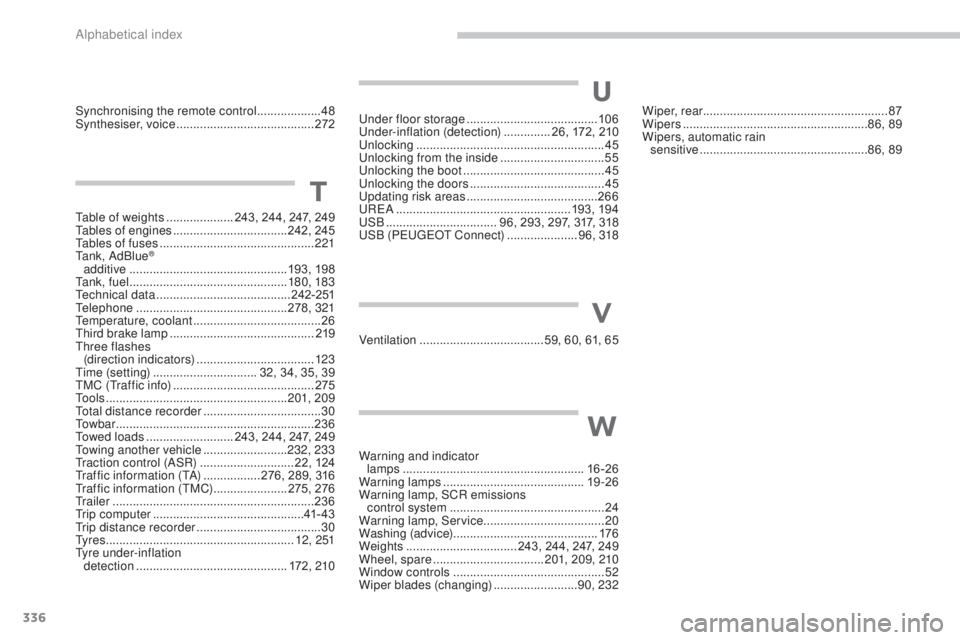2016 PEUGEOT 3008 traction control
[x] Cancel search: traction controlPage 24 of 344

22
3008_en_Chap01_controle-marche_ed01-2015
Warning/indicator lampis onCause Action / Observations
Engine
autodiagnosis
system flashing.
The engine management system has
a fault. Risk of destruction of the catalytic converter.
Have it checked by a PEUGEOT dealer or a qualified
workshop.
fixed. The emission control system has a
fault.
The warning lamp should go off when the engine is started.
If it does not go off, contact a PEUGEOT dealer or qualified
workshop without delay.
Low fuel levelfixed with the needle
in the red zone. When it first comes on there remains
approximately 6 litres of fuel in the
tank.
At this point, you begin to use the fuel
reserve. Refuel as soon as possible to avoid running out of fuel.
This warning lamp will come on every time the ignition
is switched on, until a sufficient addition of fuel is made.
Fuel tank capacity: approximately 60 litres
.
Never continue to drive until you run out of fuel, as
this could damage the emission control and injection
systems.
Maximum coolant
temperature fixed with the needle
in the red zone. The temperature of the cooling
system is too high. Stop as soon as it is safe to do so.
Wait until the engine has cooled down before topping
up the level, if necessary.
If the problem persists, contact a PEUGEOT dealer or
a qualified workshop.
Engine oil
pressure fixed.
There is a fault with the engine
lubrication system. You must stop as soon it is safe to do so.
Park, switch off the ignition and contact a PEUGEOT
dealer or a qualified workshop.
Dynamic
stability control
(DSC/ASR) flashing.
The DSC/ASR regulation is
operating. The system optimises traction and improves the
directional stability of the vehicle in the event of loss of
grip or trajectory.
fixed. The DSC/ASR system has a fault. Have it checked by a PEUGEOT dealer or a qualified
workshop.
Monitoring
Page 126 of 344

124
3008_en_Chap07_securite_ed01-2015
Electronic stability control (ESC)
Definitions
Anti-slip regulation (ASR)
The ASR system (also known as Traction
Control) optimises traction in order to limit
wheel slip by acting on the brakes of the driving
wheels and on the engine. It also improves
the directional stability of the vehicle on
acceleration.
Dynamic stability control (DSC)
If there is a difference between the path
followed by the vehicle and that required by
the driver, the DSC monitors each wheel and
automatically acts on the brake of one or more
wheels and on the engine to return the vehicle
to the required path, within the limits of the laws
of physics.
Emergency braking assistance
(EBA)
In an emergency, this system enables you to
reach the optimum braking pressure more
quickly and therefore reduce the stopping
distance.
It is triggered according to the speed at which
the brake pedal is pressed. This is felt by a
reduction in the resistance of the pedal and an
increase in the effectiveness of the braking.
Anti-lock braking system (ABS)
and electronic brake force
distribution (EBFD)
This system improves the stability and
manoeuvrability of your vehicle when braking
and contributes towards improved control in
corners, in particular on poor or slippery road
surfaces.
The ABS prevents wheel lock in the event of
emergency braking.
The electronic brake force distribution system
manages the braking pressure wheel by wheel. Electronic Stability Control (ESC) incorporating the following systems:
-
a
nti-lock braking system (ABS) and the electronic brake force distribution (EBFD),
-
em
ergency braking assistance (EBA),
-
w
heel anti-slip regulation (ASR) or traction control,
-
d
ynamic stability control (DSC).
Safety
Page 129 of 344

127
3008_en_Chap07_securite_ed01-2015
Grip control
Standard mode (ESC)
F Place the dial in this position.
Snow mode
Special patented traction control system which
improves traction on snow, mud and sand.
This system, the operation of which has been
optimised for each situation, allows you to
manoeuvre in most conditions of poor grip
(encountered during touring use).Mode calibrated for a low level of wheel spin,
based on the different levels of grip normally
encountered on the road.Mode which adapts its strategy to the
conditions of grip encountered for each of the
two front wheels on moving off.
(mode active up to 30 mph (50 km/h))
F
P
lace the dial in this position.
The accelerator pedal should be
pressed sufficiently to allow the
system to use the power of the engine.
Operation at high engine speeds is
completely normal.
Every time the ignition is switched off,
the system automatically resets to this
mode.
A five-position selector allows you to choose
the setting best suited to the driving conditions
encountered.
An indicator lamp associated with each mode
comes on to confirm your choice. Associated with all-season M+S (Mud
and Snow) tyres, this system offers a
compromise between safety, adhesion
and traction.
7
Safety
Page 338 of 344

336
3008_en_Chap13_index-alpha_ed01-2015
Synchronising the remote control ...................48
Synthesiser, voice ......................................... 2
72
Table of weights
....................24
3, 244 , 247, 249
Tables of engines
.................................. 242, 245
Tables of fuses
.............................................. 221
Tank, AdBlue
®
additive
............................................... 193, 198
Ta n k , f u e l
............................................... 180, 183
Technical data
........................................ 242- 2 51
Telephone
............................................. 278, 321
Temperature, coolant
...................................... 26
Third brake lamp
........................................... 219
Three flashes (direction indicators)
................................... 123
Time (setting)
..............................
.32 , 34 , 35, 39
TMC (Traffic info)
.......................................... 2
75
To o l s
...................................................... 201, 209
Total distance recorder
................................... 30
To w b a r
........................................................... 236
Towed loads
.......................... 243, 244 , 247, 249
Towing another vehicle
......................... 2
32, 233
Traction control (ASR)
............................ 22, 124
Traffic information (TA)
................. 276, 289 , 316
Traffic information (TMC)
...................... 2
75, 276
Tr a i l e r
............................................................ 236
Trip computer
............................................. 41- 4 3
Trip distance recorder
..................................... 30
Ty r e s
........................................................ 12 , 2 51
Tyre under-inflation detection
............................................. 172, 210
U
T
Under floor storage ....................................... 10 6
Under-inflation (detection) .............. 2
6, 172, 210
Unlocking
..............................
..........................45
Unlocking from the inside
...............................55
U
nlocking the boot .......................................... 45
Unlocking the doors
........................................ 45
Updating risk areas
....................................... 26
6
UREA
.................................................... 193, 19 4
USB
................................. 96, 293, 297, 317, 318
USB ( P
E
UGEOT
C
onnect)
.....................96,
318Wiper, rear
....................................................... 87
Wipers .......................................................86, 89
Wipers, automatic rain sensitive
..................................................86, 89
Ventilation
..............................
.......59, 60, 61, 65
V
Warning and indicator
lamps .............................. ........................16 -26
Warning lamps
.......................................... 19-26
Warning lamp, SCR emissions control system
.............................................. 24
W
arning lamp, Service .................................... 20
Washing (advice) ........................................... 176
Weights
................................. 243, 244 , 247, 249
Wheel, spare
................................. 201, 209 , 210
Window controls
............................................. 52
Wiper blades (changing)
......................... 90,
232
W
Alphabetical index